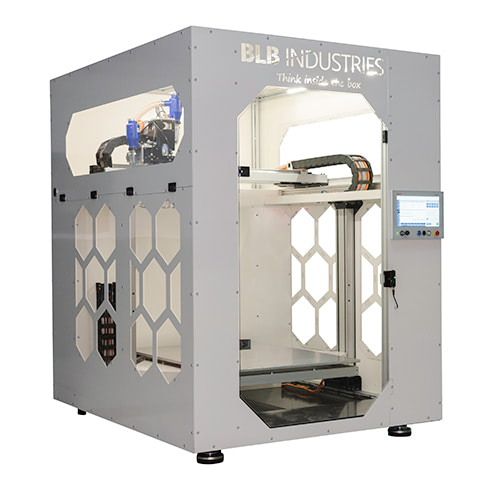
Plastic filament feedstocks can be a pain in the neck for a variety of reasons.
Depending on the filament, you may need to change the extruder or the feeder system. And let’s not get started on the price of some of the more technical filaments, with some of them running into several hundreds of dollars per kilogram. Surely the base polymer can’t be that expensive? No, they aren’t.
Wouldn’t it be great if you could just buy the same base polymer in granular form, chuck it into a printer, and do exactly the same job, minus the middleman? Cool, right?
Swedish printer maker BLB Industries clearly have the same idea, and so have addressed this with their range of granular polymer printers. And they are BIG printers too.
BLB Industries offer several variations of their printers, each named “The Box”, with some subtitles explaining the size of the machine.
The Box small, The Box medium, The Box large, and of course, The Box custom are all on offer.
Who said engineers couldn’t creatively name products? We’re just pragmatic, OK?
How Does it Work?
All The Boxes use the FGF (Fused Granular Fabrication) method of printing, with industry-standard granules. These off-the-shelf granules reduce material costs and allow for a much wider choice of materials. You can probably guess from the name how it works. You put the granules in, some magic happens, and a track of molten polymer is deposited from the extruder nozzle. It’s the same principle (rheologically speaking) as filament deposition.
What is the magic bit though? Take a look at the graphic below.

Image credit: Manufacturing Guide
It looks like the business end of an injection moulding system, right? Except it’s been rotated 90 degrees vertically.
You can see the granules are fed into the hopper (1), where they are gravity fed into the heated cylinder (3). The extrusion screw (2) metres the granules as they pass through the heaters, and the granules become liquified as they approach the nozzle (4), where they are finally extruded as the molden track onto the heated bed (5). Item (6) shows the part itself. And similar to filament methods, support structures are required for overhangs. Simple.
The Printers
Let’s take a look at some of the machine stats and capabilities. Displayed below is The Box (small).
BLB Industries The BOX SMALL
Features
- – XL build size: 1500 x 1000 x 1000 mm
- – Granular extruder, which reduces material costs
- – Fast build rate: up to 14 kg per hour
- – 15″ touch screen
- – High quality linear motion modules from Rexroth
Specifications »




Don’t let the name fool you. This is not a small printer. It’s just named as such because it is the smallest in the BLB range. In fact, it has a build volume of 1500 x 1000 x 1000 mm, and depending on the nozzle choice it can extrude up to 14kg of material per hour, with a maximum part size of 250kg! Speaking of nozzles, the small nozzle allows extrusions of 1-2mm diameter, and the “medium” nozzles come in varieties of 2-8mm. That’s why it can spit out 14kg per hour.
The Box large version, has a build volume of 2000 x 2000 x 1500 mm, and has nozzle options of up to 14mm! As wide as your thumb! This allows mass deposition rates of up to 30kg/hour for parts up to 1000kg in mass. Whew!
Got GROT?
Of course, not having to mess around with the extruder or feed system means these systems are fairly versatile in terms of granular feedstock.
The BLB systems can accept a wide range of feedstocks, including ABS, TPU, and of course, that delicious Grot.
Wait, what?
Grot, is a biomaterial made from forestry waste (bits of branches and tree tops). It comes from the Swedish Grenar Och Toppar, or GROT for short. You can see what it looks like below. On a personal note, this writer is curious to see what GROT prints like and what the final part looks (and smells) like! The granules look oddly delicious. We don’t recommend you eat them though.




In addition to the GROT there are a bunch of other approved materials available for The Box machines, and also some special granules with additives. You can see the list here.
So there it is. A selection of XL 3D printers, with a wide array of polymers for testing in granule form.


